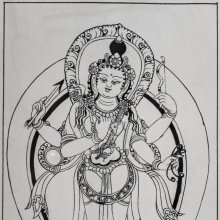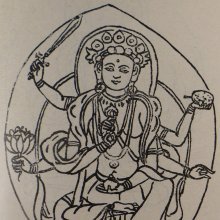Yamadanda, Yamadaṇḍa, Yama-danda, Yamadamda: 12 definitions
Introduction:
Yamadanda means something in Buddhism, Pali, Hinduism, Sanskrit, Jainism, Prakrit, Marathi. If you want to know the exact meaning, history, etymology or English translation of this term then check out the descriptions on this page. Add your comment or reference to a book if you want to contribute to this summary article.
Images (photo gallery)
In Hinduism
Natyashastra (theatrics and dramaturgy)
Source: Wisdom Library: Nāṭya-śāstraYamadaṇḍa (यमदण्ड) is a Sanskrit word referring to the rod of Yama. Acording to the Nāṭyaśāstra 1.82-88, when Brahmā, Indra and all other gods went to inspect the playhouse (nāṭyamaṇḍapa) designed by Viśvakarmā, he assigned different deities for the protection of the playhouse itself, as well as for the objects relating to dramatic performance (prayoga).
As such, Brahmā assigned Yamadaṇḍa to the door-frame (threshold, dehalī). The protection of the playhouse was enacted because of the jealous Vighnas (malevolent spirits), who began to create terror for the actors.

Natyashastra (नाट्यशास्त्र, nāṭyaśāstra) refers to both the ancient Indian tradition (shastra) of performing arts, (natya—theatrics, drama, dance, music), as well as the name of a Sanskrit work dealing with these subjects. It also teaches the rules for composing Dramatic plays (nataka), construction and performance of Theater, and Poetic works (kavya).
Purana and Itihasa (epic history)
Source: archive.org: Shiva Purana - English TranslationYamadaṇḍa (यमदण्ड) refers to “Yama’s staff”, according to the Śivapurāṇa 2.4.5 (“Kārttikeya is crowned”).—Accordingly, after the Kṛttikās spoke to Kārttikeya: “[...] Then Śiva, the lord of the universe, following the worldly convention delightedly placed Kārttikeya on a beautiful gemset throne. [...] Then Indra gave him a lordly elephant and a thunderbolt. The lord of the waters, Varuṇa, gave him a white umbrella and a necklace of gems to wear. The sun gave him a chariot as fast as the mind and a coat of mail with great equipments; Yama his own staff (yamadaṇḍa): the moon a vessel full of nectar. [...]”.
Source: Cologne Digital Sanskrit Dictionaries: The Purana IndexYamadaṇḍa (यमदण्ड).—An adhikāra.*
- * Matsya-purāṇa 225. 16; Vāyu-purāṇa 108. 4.

The Purana (पुराण, purāṇas) refers to Sanskrit literature preserving ancient India’s vast cultural history, including historical legends, religious ceremonies, various arts and sciences. The eighteen mahapuranas total over 400,000 shlokas (metrical couplets) and date to at least several centuries BCE.
In Buddhism
Tibetan Buddhism (Vajrayana or tantric Buddhism)
Source: archive.org: The Indian Buddhist IconographyYamadaṇḍa (यमदण्ड) or Yamadaṇḍalokeśvara refers to number 33 of the 108 forms of Avalokiteśvara found in the Machhandar Vahal (Kathmanu, Nepal). [Machhandar or Machandar is another name for for Matsyendra.].
Accordingly,—
“Yamadaṇḍa is one-faced and six-armed, and sits in the Lalita attitude on a lotus. His three right hands hold the sword, the lotus and the Vajra, while his three left display the fruit, the bowl of gems and an unspecified mudrā (Karaṇa ?)”.
The names of the 108 deities [viz., Yamadaṇḍa] possbily originate from a Tantra included in the Kagyur which is named “the 108 names of Avalokiteshvara”, however it is not yet certain that this is the source for the Nepali descriptions. Tibetan Buddhism includes schools such as Nyingma, Kadampa, Kagyu and Gelug. Their primary canon of literature is divided in two broad categories: The Kangyur, which consists of Buddha’s words, and the Tengyur, which includes commentaries from various sources. Esotericism and tantra techniques (vajrayāna) are collected indepently.
In Jainism
General definition (in Jainism)
Source: archive.org: Een Kritische Studie Van Svayambhūdeva’s PaümacariuYamadaṇḍa (यमदण्ड) participated in the war between Rāma and Rāvaṇa, on the side of the latter, as mentioned in Svayambhūdeva’s Paumacariu (Padmacarita, Paumacariya or Rāmāyaṇapurāṇa) chapter 57ff. Svayambhū or Svayambhūdeva (8th or 9th century) was a Jain householder who probably lived in Karnataka. His work recounts the popular Rāma story as known from the older work Rāmāyaṇa (written by Vālmīki). Various chapters [mentioning Yamadaṇḍa] are dedicated to the humongous battle whose armies (known as akṣauhiṇīs) consisted of millions of soldiers, horses and elephants, etc.
Source: archive.org: TrisastisalakapurusacaritraYamadaṇḍa (यमदण्ड) refers to the door-keeper of Laṅkā, according to the Jain Ramayana and chapter 7.7 [The killing of Rāvaṇa] of Hemacandra’s 11th century Triṣaṣṭiśalākāpuruṣacaritra: an ancient Sanskrit epic poem narrating the history and legends of sixty-three illustrious persons in Jainism.—Accordingly, “After reciting this hymn of praise to Śānti, the lord of Laṅkā, occupying a jeweled slab before (him), began to subdue the vidyā, holding a rosary. Then Mandodarī said to the door-keeper, Yamadaṇḍa: ‘All the people of the city must be devoted to the Jinas’ religion for eight days. Whoever will not do this, of him there will be punishment consisting of death—Proclaim this in Laṅkā by beat of drums’ [...]”.

Jainism is an Indian religion of Dharma whose doctrine revolves around harmlessness (ahimsa) towards every living being. The two major branches (Digambara and Svetambara) of Jainism stimulate self-control (or, shramana, ‘self-reliance’) and spiritual development through a path of peace for the soul to progess to the ultimate goal.
Languages of India and abroad
Marathi-English dictionary
Source: DDSA: The Molesworth Marathi and English Dictionaryyamadaṇḍa (यमदंड).—m (S) The punishment inflicted upon sinners by Yama.
Marathi is an Indo-European language having over 70 million native speakers people in (predominantly) Maharashtra India. Marathi, like many other Indo-Aryan languages, evolved from early forms of Prakrit, which itself is a subset of Sanskrit, one of the most ancient languages of the world.
Sanskrit dictionary
Source: Cologne Digital Sanskrit Dictionaries: Cappeller Sanskrit-English DictionaryYamadaṇḍa (यमदण्ड).—[masculine] Yama's rod.
Source: Cologne Digital Sanskrit Dictionaries: Monier-Williams Sanskrit-English DictionaryYamadaṇḍa (यमदण्ड):—[=yama-daṇḍa] [from yama > yam] m. Y°’s rod, [Rāmāyaṇa; Kathāsaritsāgara]
[Sanskrit to German]
Sanskrit, also spelled संस्कृतम् (saṃskṛtam), is an ancient language of India commonly seen as the grandmother of the Indo-European language family (even English!). Closely allied with Prakrit and Pali, Sanskrit is more exhaustive in both grammar and terms and has the most extensive collection of literature in the world, greatly surpassing its sister-languages Greek and Latin.
Kannada-English dictionary
Source: Alar: Kannada-English corpusYamadaṃḍa (ಯಮದಂಡ):—
1) [noun] the mace of Yama, the God of Death and righteousness.
2) [noun] any of the punishments awarded by Yama.
Kannada is a Dravidian language (as opposed to the Indo-European language family) mainly spoken in the southwestern region of India.
See also (Relevant definitions)
Partial matches: Yama, Danda, Tanta.
Starts with: Yamadandalokeshvara.
Full-text: Khetaka, Praharanem, Asilata, Akanda, Yamadandalokeshvara.
Relevant text
Search found 11 books and stories containing Yamadanda, Yama-danda, Yama-daṇḍa, Yamadamda, Yamadaṃḍa, Yamadaṇḍa; (plurals include: Yamadandas, dandas, daṇḍas, Yamadamdas, Yamadaṃḍas, Yamadaṇḍas). You can also click to the full overview containing English textual excerpts. Below are direct links for the most relevant articles:
The Story of the Rishi Vidyuccora < [September 1943]
The Indian Buddhist Iconography (by Benoytosh Bhattachacharyya)
Garga Samhita (English) (by Danavir Goswami)
Verse 2.5.9 < [Chapter 5 - The Liberation of Bakāsura]
Verse 2.5.10 < [Chapter 5 - The Liberation of Bakāsura]
Chaitanya Bhagavata (by Bhumipati Dāsa)
Verse 3.2.377 < [Chapter 2 - Description of the Lord’s Travel Through Bhuvaneśvara and Other Placesto Jagannātha Purī]
Verse 2.25.19 < [Chapter 25 - The Discourse on Spiritual Knowledge by Śrīvāsa’s Dead Son]
Verse 2.9.37-038 < [Chapter 9 - The Lord’s Twenty-One Hour Ecstasy and Descriptions of Śrīdhara and Other Devotees’ Characteristics]
Jain Remains of Ancient Bengal (by Shubha Majumder)
Ṛṣabhanātha sculptures with miniature Tīrthaṅkaras and Dikpālas < [Chapter 6 - Iconographic Study of Jaina Sculptural Remains]
Sahitya-kaumudi by Baladeva Vidyabhushana (by Gaurapada Dāsa)
Text 10.153 < [Chapter 10 - Ornaments of Meaning]

